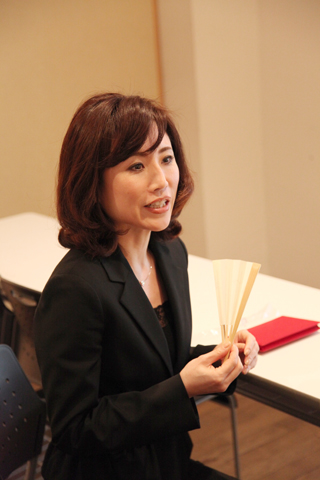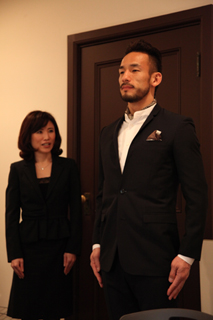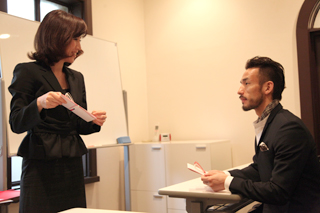What is Etiquette?

”Reigi” or manners is to be considerate of others. You express this spirit through ”saho” or etiquette. The spirit and method are a set, making ”reiho” or etiquette whole.” Master of Ogasawara ”Reiho”, Ogasawara Keisho told us. She is the very first female master.
Ogasawara-ryu Reiho dates back to the Muromachi period, and was the ”reiho” form for Japanese archery, horsemanship, military practices, etc. for the samurai society as a whole. ”Reiho” was succeeded by the late Ogura Feudal Lord Tadamune Ogura of the Ogura main family, and he established the current Ogasawara-ryu Reiho headquarters in the Showa era.
Since Ogasawara-ryu ”reiho” was originally for the samurai, it later became the official ”reiho” for the Shogunate. Commoners considered this of ”high prestige”, and as a result, it flourished among normal citizens during the Edo period.
The ”Heart” of Being Considerate towards Others

Ogasawara Keisho asked Nakata to fan himself, handing him a fan. ”Can you fan yourself with this?” she said. Nakata looked a bit perplexed as he took the fan, opened it and fanned himself.
”Yes, that is how it would normally be used. However according to the Ogasawara way, we leave the fan partially closed.”
In other words, fanning with the fan fully open would be a display of how hot you’re feeling, causing concern from others, so it is important to be reserved with the fan.
The basics of etiquette is being considerate of others.
For instance, when you bow, you do not say ”Thank you,” while bowing. You should look at the person directly in the eyes and convey gratitude. Be sure not to bow multiple times, as it makes it seem casual. You should also lower and raise your head at the same speed. Inhale while bending forward, exhale when you stop, then inhale again as you return to the upright position. Of course, it’s best to be aware of these ”forms”. But what is important is understanding the correct moment and the spirit that is to be conveyed.
”Our predecessors have always believed that while times change, the spirit remains consistent.” Although the ways of life and styles may change, the underlying ”spirit” will never change.”
Minimum Etiquette

”It may be difficult for us to formally incorporate every single detail of ”reiho”, but can you tell us what you think should be done at the very least?”
As Nakata asked in all honesty, Keishosai responded. ”As I mentioned earlier, ”reigi” is about always being considerate of others. So, the least a person should do is to be careful not to cause anyone discomfort. This spirit is the minimum of ”reigi”. Keep this in mind and act gracefully and naturally. This indeed is ”reiho”. For this, it’s important to understand timing and to keep this spirit at all times.”
Always maintain a spirit of consideration for others, and take into consideration the time, place and occasion. The students are told that ”the key is to come to this realization for yourself”. The master herself told us that she decided to immerse herself in this world when she left to study in the UK and ”realized ” the beauty of Japanese culture.



